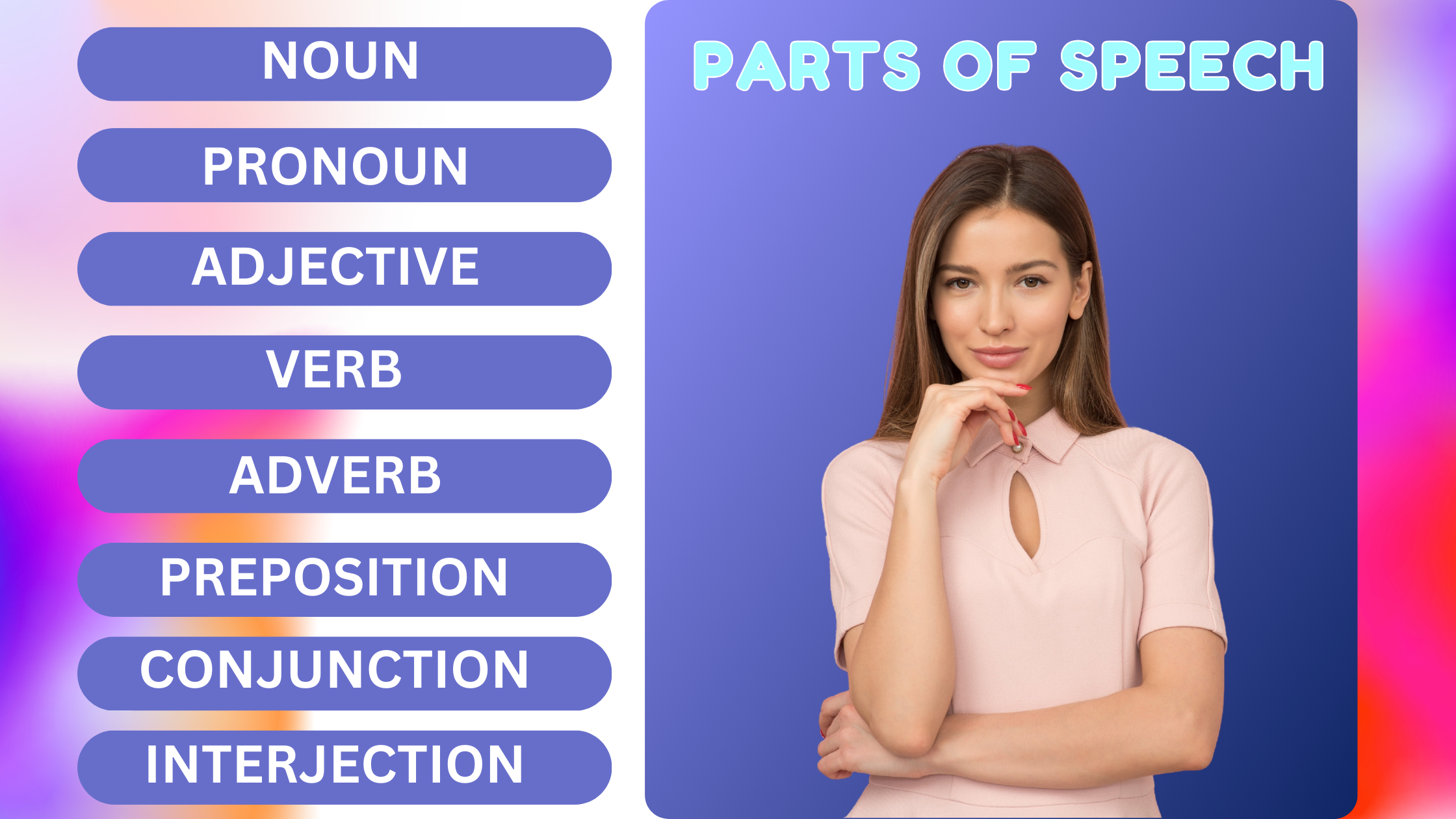Understanding Parts of Speech in British English

The English language is a rich tapestry of words, phrases, and expressions that allow us to communicate effectively. At the foundation of this intricate language system lies the concept of “parts of speech.” Understanding parts of speech is essential for mastering English grammar, improving writing skills, and fostering effective communication. This blog explores the parts of speech as they are used in British English, delving into each category with examples and explanations.
What Are Parts of Speech?
Parts of speech are the categories into which words are grouped based on their function in a sentence. In British English, as in other variants of English, there are eight primary parts of speech:
1.Nouns
2.Pronouns
3.Verbs
4.Adjectives
5.Adverbs
6.Prepositions
7.Conjunctions
8.Interjections
Each part of speech plays a unique role in sentence construction, contributing to the clarity, style, and meaning of the communication.
1. Nouns
Nouns are words that name people, places, things, ideas, or concepts. They form the backbone of sentences, often functioning as the subject or object.
Types of Nouns
1. Proper Nouns:
These refer to specific names and are always capitalised. Examples: London, Elizabeth II, Oxford University.
2. Common Nouns:
These refer to general items or concepts. Examples: city, queen, university.
3. Countable Nouns:
These can be counted. Examples: apple, chair, book.
4. Uncountable Nouns:
These cannot be counted. Examples: water, sugar, information.
5. Abstract Nouns:
These refer to intangible concepts. Examples: happiness, freedom, justice.
6. Collective Nouns:
These refer to groups. Examples: team, flock, audience.
Examples in Sentences:
- The Tower of London is a historic landmark. (Proper noun)
- She bought a loaf of bread from the shop. (Common noun)
2. Pronouns
Pronouns are words used in place of nouns to avoid repetition. They simplify sentences and improve their flow.
Types of Pronouns
1. Personal Pronouns:
Represent specific people or things. Examples: I, you, he, she, it, we, they.
2. Possessive Pronouns:
Indicate ownership. Examples: mine, yours, his, hers, ours, theirs.
3. Reflexive Pronouns:
Refer back to the subject. Examples: myself, yourself, himself.
4. Demonstrative Pronouns:
Point to specific things. Examples: this, that, these, those.
5. Relative Pronouns:
Introduce relative clauses. Examples: who, whom, which, that.
6. Interrogative Pronouns:
Used in questions. Examples: who, what, which.
7. Indefinite Pronouns:
Refer to unspecified things. Examples: someone, nobody, anything.
Examples in Sentences:
- He gave her the book. (Personal pronoun)
- That is my favourite painting. (Demonstrative pronoun)
3. Verbs
Verbs are words that express actions, states, or occurrences. They are crucial for forming sentences.
Types of Verbs
1. Action Verbs:
Indicate actions. Examples: run, jump, write.
2. Stative Verbs:
Indicate states or conditions. Examples: be, seem, belong.
3. Auxiliary Verbs:
Help main verbs form tenses. Examples: is, have, do.
4. Modal Verbs:
Express necessity, possibility, or ability. Examples: can, could, should, must.
Examples in Sentences:
- She writes letters every day. (Action verb)
- He must complete the assignment by tomorrow. (Modal verb)
4. Adjectives
Adjectives describe or modify nouns and pronouns, providing more information about them.
Types of Adjectives
1. Descriptive Adjectives:
Describe qualities. Examples: beautiful, tall, blue.
2. Quantitative Adjectives:
Indicate quantity. Examples: some, many, few.
3. Demonstrative Adjectives:
Point to specific nouns. Examples: this, that, these.
4. Possessive Adjectives:
Show ownership. Examples: my, your, his.
5. Comparative and Superlative Adjectives:
Compare things. Examples: better, best, taller, tallest.
Examples in Sentences:
- The old house was painted red. (Descriptive adjective)
- She has three cats. (Quantitative adjective)
5. Adverbs
Adverbs modify verbs, adjectives, or other adverbs. They often answer questions such as how, when, where, and to what extent.
Types of Adverbs
1. Adverbs of Manner:
Describe how actions are performed. Examples: quickly, softly.
2. Adverbs of Time:
Indicate when something happens. Examples: yesterday, soon.
3. Adverbs of Place:
Indicate location. Examples: here, there.
4. Adverbs of Degree:
Indicate intensity. Examples: very, quite.
Examples in Sentences:
- She sings beautifully. (Adverb of manner)
- They will arrive tomorrow. (Adverb of time)
6. Prepositions
Prepositions are words that show relationships between nouns (or pronouns) and other elements in a sentence. They often indicate direction, location, or time.
Common Prepositions
1. Direction:
to, towards, into.
2. Location:
in, on, under.
3. Time:
at, during, before.
Examples in Sentences:
- The book is on the table. (Location)
- We met during the conference. (Time)
7. Conjunctions
Conjunctions connect words, phrases, or clauses. They ensure sentences are coherent and ideas are logically linked.
Types of Conjunctions
1. Coordinating Conjunctions:
Link elements of equal importance. Examples: and, but, or, so.
2. Subordinating Conjunctions:
Link dependent clauses to main clauses. Examples: because, although, if.
3. Correlative Conjunctions:
Work in pairs. Examples: either…or, neither…nor.
Examples in Sentences:
- She likes tea and coffee. (Coordinating conjunction)
- Although it was raining, they went for a walk. (Subordinating conjunction)
8. Interjections
Interjections are words or phrases that express strong emotions or reactions. They are often standalone words.
Examples:
Wow! (Surprise)
Oh no! (Disappointment)
Hurrah! (Joy)
Examples in Sentences:
Wow! That was an amazing performance.
Alas, the opportunity was lost.
Tips for Identifying Parts of Speech
Analyse the Function: Consider the role a word plays in a sentence. For example, “run” can be a verb (I run daily) or a noun (He went for a run).
Look for Clues: Context, surrounding words, and sentence structure provide hints.
Consult a Dictionary: Dictionaries often list the part of speech alongside definitions.
Conclusion
Mastering parts of speech is a fundamental step in improving your command of British English. Each part of speech contributes uniquely to sentence structure and meaning, making the language dynamic and versatile. By understanding and practising these categories, you can enhance your writing, speaking, and comprehension skills, whether you are a native speaker or a learner. As with any aspect of language, consistent practice and observation are key to mastery.

